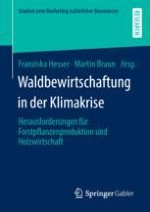2023 | OriginalPaper | Buchkapitel
Baumartenwechsel und Herkunftswahl im Klimawandel
verfasst von : Silvio Schüler, Katharina Lapin, Debojyoti Chakraborty
Erschienen in: Waldbewirtschaftung in der Klimakrise
Verlag: Springer Fachmedien Wiesbaden
Aktivieren Sie unsere intelligente Suche, um passende Fachinhalte oder Patente zu finden.
Wählen Sie Textabschnitte aus um mit Künstlicher Intelligenz passenden Patente zu finden. powered by
Markieren Sie Textabschnitte, um KI-gestützt weitere passende Inhalte zu finden. powered by
